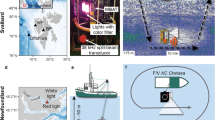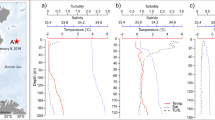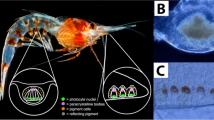Abstract
The eye of the 'eyeless' shrimp Rimicaris exoculata is unusual in having no image-forming optics and a high concentration of rhodopsin1. The shrimps swarm around 350 °C hydrothermal 'black smoker' vents in the Mid-Atlantic Ridge2. There is no other known source of visible light in the shrimp's environment. The spectral sensitivity of rhodopsin is well matched to typical spectra of bioluminescence of organisms found at lesser depths, but other animals detect such emissions without the unusual features of the R. exoculata eye1. These two features are most easily understood as an adaptation for the detection of extremely faint sources of light. Physical calculations presented here indicate that the shrimp could see the black-body radiation of the 350 °C vents, even though these sources are practically invisible to the human eye. This would be useful to the shrimp as it feeds on sulphide-loving bacteria very near to the vents3 but must avoid the lethal 350 °C vents themselves.
This is a preview of subscription content, access via your institution
Access options
Subscribe to this journal
Receive 51 print issues and online access
$199.00 per year
only $3.90 per issue
Buy this article
- Purchase on Springer Link
- Instant access to full article PDF
Prices may be subject to local taxes which are calculated during checkout
Similar content being viewed by others
References
Van Dover, C. L., Szuts, E. Z., Chamberlain, S. C. & Cann, J. R. Nature (in this issue).
Thompson, G., Humphries, S. E., Schroeder, B., Sulanowska, M. & Rona, P. A. Canadian Mineralogist 26, 697–711 (1988).
Van Dover, C. L., Fry, B., Grassle, J. F., Humphris, S. & Rona, P. A. Mar. Biol. 98, 209–216 (1988).
Browne, M. W. New York Times, August 9, 1988, B5 (1988).
Wyszecki, G. & Stiles, W. S. Color Science 2nd edn, (Wiley, New York, 1982).
Stiles, W. S. & Wyszecki, G. Vision Res. 14, 195–207 (1974).
Baylor, D. A., Nunn, B. J. & Schnapf, J. L. J. Physiol. 357, 575–607 (1984).
Pirenne, M. H. in The Eye Vol. 2 (ed. Davson, H. Academic, New York, 1962).
Dartnall, H J. A. in Handbook of Sensory Physiology Vol. VII, Part 1, Photochemistry of Vision (ed. Dartnall, H J A. Springer, Berlin, 1972)
Author information
Authors and Affiliations
Rights and permissions
About this article
Cite this article
Pelli, D., Chamberlain, S. The visibility of 350 °C black-body radiation by the shrimp Rimicaris exoculata and man. Nature 337, 460–461 (1989). https://doi.org/10.1038/337460a0
Received:
Accepted:
Issue Date:
DOI: https://doi.org/10.1038/337460a0
This article is cited by
-
Visual prey detection by near-infrared cues in a fish
Naturwissenschaften (2012)
-
Origins of photosynthesis
Nature (1995)
-
The sight of deep wet heat
Nature (1989)
-
A novel eye in 'eyeless' shrimp from hydrothermal vents of the Mid-Atlantic Ridge
Nature (1989)
Comments
By submitting a comment you agree to abide by our Terms and Community Guidelines. If you find something abusive or that does not comply with our terms or guidelines please flag it as inappropriate.



